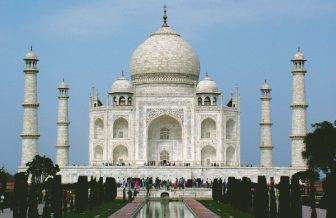The Taj Mahal stands on the banks of the Yamuna River in the city of Agra, in the northern Indian state of Uttar Pradesh. It is one of the most recognized buildings in the world. The Taj Mahal is actually a complex containing a mausoleum, a mosque, a guesthouse, a large entrance gate, and extensive gardens filled with waterways, pools, and fountains. The monument was constructed in the 17th century under the direction of Shah Jahan at the peak of Mughal power in India.
The Mughal Empire (AD 1526-1707) was a stable unifying force in India for two centuries. Its roots can be traced back to Central Asia. Mughal is the Indian spelling of Mongol. The Mughal style blends balance and harmony with intricate decoration. Mughal influence is still seen throughout India today in architecture, language, customs, and fashion.
 Shah Jahan rose to the throne at the peak of the empire’s power and glory in 1627 after five years of rebellion against his father. Mughals had no system for determining ascension to the throne, so imperial princes were forced to fight for it. The strongest or smartest would become the next emperor. Shah Jahan immediately ordered the deaths of a brother, nephew, and some cousins to clear away possible rivals. He settled his family into Akbar’s Red Fort palace, took control of the empire, and commenced almost 30 years of peaceful rule.
Shah Jahan rose to the throne at the peak of the empire’s power and glory in 1627 after five years of rebellion against his father. Mughals had no system for determining ascension to the throne, so imperial princes were forced to fight for it. The strongest or smartest would become the next emperor. Shah Jahan immediately ordered the deaths of a brother, nephew, and some cousins to clear away possible rivals. He settled his family into Akbar’s Red Fort palace, took control of the empire, and commenced almost 30 years of peaceful rule.
Shah Jahan’s favorite wife was Mumtaz Mahal. She was beautiful and very intelligent and would accompany the Shah everywhere as his closest adviser. When she died in 1630 while giving birth to his fourteenth child, Shah Jahan went into deep mourning for two years. In 1632, he ordered the construction of a mausoleum at Agra to house her remains. The entire project took 22 years to complete with the efforts of 20,000 laborers and craftsmen.
Two supervisors were chosen to oversee the project. Workers came from all areas of the empire, Persia, and Central Asia. A site was selected on a bend of the Yamuna River in sight of the Red Fort. To prepare the site, a deep foundation was set on arches. This base was constructed to protect the mausoleum against flooding during the monsoon season. The base for the tomb was constructed from red sandstone, a common building material of the time. The tomb itself, however, was built of solid white marble, which appears to change color in the light at various times of the day. The marble is covered with intricate inlay of precious and semiprecious stones incorporating three major elements seen in Muslim art: passages from the Qur’an, flowers and plants, and geometric designs. The artisans were so skilled that it is very difficult to see any seams in the marble panels. As you read the passages going up the wall, the letters gradually increase in size so the lettering looks uniform from the floor. The calligraphy inlay was created with onyx. Twenty-eight varieties of precious stones were used for the designs. Materials were brought great distances by elephant, including jade and crystal from China, turquoise from Tibet, sapphire and lapis lazuli from Sri Lanka, and more.
The stone monuments for Shah Jahan and Mumtaz Mahal are in a large central chamber under the dome. A lacy marble screen keeps visitors at a respectful distance. The actual tombs are in a chamber beneath that. The tomb chamber originally had massive silver doors, chandeliers, and precious Persian carpets. The tombs were covered with sheets of pearls. All of the finery here was stripped and carried away by marauding soldiers more than one hundred years later when the empire was in a shambles.
The Taj Mahal is flanked by two matching red sandstone structures. One side is a mosque for guests to pray in, and the other side is a guesthouse for visitors. The garden is divided into four quadrants by waterways representing the four rivers of Paradise. Each quadrant is divided into four, and those again into four, making an ordered, symmetrical grid. The gardens are filled with shade trees and flowers. Fountains and a reflecting pool make a peaceful place for walking. The entrance of the huge front gate perfectly frames the entrance to the tomb. The design of the Taj Mahal both structurally and decoratively expresses joy and happiness; Islamic tombs are not meant to be places of sorrow. The Taj Mahal epitomizes joy, balance, and harmony.
References:
- Nou, J. (1993). Taj Mahal. New York: Abbeville Press. Rothfarb, E. (1998). In the land of the Taj Mahal: The world of the fabulous Mughals. New York: Henry
- Holt and Company. Stierlin, H. (2002). Islamic art and architecture. New York: Thames and Hudson.
Like? Share it!
